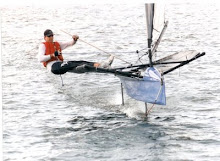
The posting of Adam's picture of me swimming in at the Gorge (above), recent blog posts by Nat and by MARKLA, and last week's sailing at the HHPDO in Rye, have all got me thinking about gantry forces.
When I built my first rudder/gantry system I was most influenced by Bill's comment that the back of his rudder cassette had blown out during a heavy air day. To prevent the same thing from happening to my boat I made a cassette that was probably overbuilt, but didn't fail. That first rudder and horizontal were serviceable (they're what I'm using in the photo on the right sidebar) but I was sure that the whole sytem was less than optimal, due to the size of the horizontal; and to the thickness of the strut.

In building a second rudder for the Worlds, I wanted to accomplish four things: (1) reduce drag by using John Z's thinner strut section and a much smaller horizontal (eventually a Beiker section built by Bora,) (2) reduce weight by eliminating the rudder cassette concept and instead pin the rudder directly to the gantry (and using a rudder with a hollow tube head and removable tiller/hiking stick to make the system managable,) (3) improve the worm gear set-up to make the adjustments more positive and easier to accomplish, and (4) incorporate a five degree forward cant similar to the Mach2 design to help prevent ventilation.

After an unfortunate sail/break/repair cycle the current product can be seen in the above photo of me sailing in the Heineken regatta last weekend. I'm generally pleased with the rudder, tiller, and forward cant, but am still worried about the strength of the lower gudgeon and the gantry attachment points. Looking at pictures of the rudder when sailing in heavy air, it became obvious to me that there is a huge amount force applied to the lower gudgeon, and that at speed, while the amount of force decreases linearly with the ride height, it increases quadratically (not exponentially, Karl) with the speed through the water. The best way to reduce straight line drag would be to fly higher and to incorporate thinner strut and foil sections, with very fine surface finishes (maybe even with a SLIP coating?) all of which I'm well on to way to accomplishing. The dynamic drag force is high with erratic steering, something that I may have to deal with for a while until I get my helmsmanship skills up to par. All of these drag forces are trying to rip the gantry off the boat, or the rudder out of the back of the cassette, if so equipped, or the lower gudgeon off the leading edge of the rudder.
When I went to the Gorge Worlds I brought my new rudder and gantry, neither of which had ever been used before (BIG MISTAKE!) Adam's photo was taken after the gantry lower tension tube separated. The plug that attached the bottle screw to the carbon tube came out causing a cascade of failures (how appropriate?) with the gantry's upper attachment points ripping off at the hull connection. It's too bad that I didn't get seamanship points for nursing the boat back to the beach without the rudder. Additional style points could have been awarded for allowing the rudder's horizontal to appear as a shark's fin cutting the surface behind me! I repaired these failures with a rather agricultural-looking aluminum plate and through bolts for all the tube plugs and eventually managed to get in some racing, even recording a 20.3 knot 10 second average speed on the afternoon of the speed challenge. On the second-to-last day of racing, however, I again had a rudder failure, this time with the lower gudgeon popping off the rudder.


In preparation for last weekend's regatta I replaced the lower gudgeon, reinforced it with ten layers of carbon cloth, and bolted the fitting through the rudder, in addition to the glued attachment. Things held up for the racing (the only failure that occured was not rudder related, but at the other end of the boat at the wand pivot.) But close inspection of the joint reveals stress that caused the primer paint to crack. Obviously, I need to re-engineer this lower rudder fitting! Again. Stay tuned for the winter project that will include a whole new gantry with different hull attachment points the will reduce play in the whole system. The work of the home builder is never completely "sorted."

Sailing photos by Allen and Daniela Clark from The Photoboat.com


4 comments:
quadratically? What do I win?
You're right, of course. Related to the cross sectional area, not volume. But may some frioctional component will raise the power slightly above 2? A fractal dimension?
Since when is two not an exponent?
Sorry, it's the mathematical terminology - "exponential" functions have a fixed base and a variable exponent. We need a variable base (the wind speed) and a fixed exponent, two being quadratic, three being cubic, 2.1 being a fractal, etc., all properly termed "power" functions.
Post a Comment